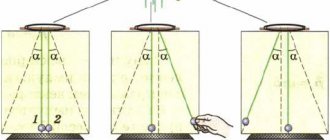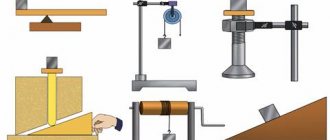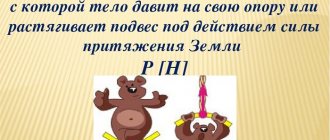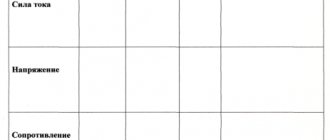Test with answers: “Newton’s Laws”
I option.
1. In which reference systems are all three laws of Newton’s mechanics satisfied: a) only in non-inertial systems b) only in inertial systems + c) in any reference systems
2. Newton’s first law is formulated as follows: a) There are such reference systems relative to which bodies retain their speed unchanged if they are not acted upon by other bodies + b) The forces two bodies act on each other are equal in magnitude and opposite in direction in ) The acceleration of a body is directly proportional to the resultant forces applied to the body and inversely proportional to its mass
3. Newton’s third law is formulated as follows: a) There are such reference systems relative to which bodies retain their speed unchanged if they are not acted upon by other bodies b) The acceleration of a body is directly proportional to the resultant forces applied to the body and inversely proportional to its mass c) the force with which the first body acts on the second is equal in magnitude and opposite in direction to the force with which the second body acts on the first +
4. Under the influence of a force of 20 N, a body moves with an acceleration of 5 m/s2. What is the body weight: a) 4 kg + b) 0.25 kg c) any
5. Which of the following expressions corresponds to the unit of force expressed in terms of basic SI units: a) kg2 * m2/s2 b) kg * m2/s2 c) kg * m/s2 +
6. Which of the quantities: mass or force - vector: a) force and mass b) only force + c) only mass
7. The resultant of all forces acting on the body is zero. How will the body behave: a) just at rest b) move with acceleration c) move uniformly in a straight line or at rest +
8. Two forces 12N and 7N act on a body in opposite directions. The body has a mass of 2 kg. With what acceleration does the body move: a) 2.5 m/s2 + b) 0.2 m/s2 c) 25 m/s2
9. What force must be exerted on a body weighing 5 kg so that it moves with an acceleration of 0.1 m/s2: a) 1 N b) 0.1 N c) 0.5 N +
10. Two forces 2 N and 5 N act on a body in one direction and two forces 1.5 N and 8 N in the opposite direction. Determine the resultant force: a) 3.5 N b) 2.5 N + c) 10 N
11. Unit of measurement of force in SI: a) N + b) A c) J
12. Which of the quantities (speed, force, acceleration, displacement) during mechanical motion always coincide in direction: a) acceleration and displacement b) force and acceleration + c) force and speed
13. Having gone down the hill, the sled with the boy begins to slow down with an acceleration of 2 m/s2. Determine the magnitude of the braking force if the total mass of the boy and the sled is 40 kg: a) 80 N + b) 42 N c) 40 N
14. When braking, a car moves with an acceleration of 0.1 m/s2. The mass of the car is 1.5 tons. Determine the value of the braking force: a) 15 N b) 1500 N c) 150 N +
15. A lightly moving cart weighing 3 kg is pushed with a force of 6 N. Determine the acceleration of the cart: a) 2 m/s2 + b) 18 m/s2 c) 1.6 m/s2
16. How will a body weighing 4 kg move under the action of a single force of 8 N: a) uniformly accelerated, with an acceleration of 0.5 m/s2 b) uniformly accelerated, with an acceleration of 2 m/s2 + c) uniformly, with a speed of 0.5 m/ With
17. In an inertial reference frame, force F imparts acceleration a to a body of mass m. How will the acceleration of a body change if the mass of the body and the force acting on it are increased by 2 times: a) decreases by 4 times b) increases by 4 times c) does not change +
18. In an inertial reference frame, force F imparts acceleration a to a body of mass m. How will the acceleration of a body change if the mass of the body is doubled and the force acting on it is halved: a) increases by 2 times b) decreases by 4 times + c) increases by 4 times
19. In an inertial reference frame, force F imparts acceleration a to a body of mass m. How should the mass of a body be changed so that half the force imparts 4 times greater acceleration to it? a) increase by 2 times b) decrease by 2 times c) decrease by 8 times +
20. A projectile weighing 2 kg flies out of a gun barrel horizontally at a speed of 1000 m/s. Determine the pressure force of the powder gases, considering it constant, if the barrel length is 3.5 m: a) 325 kN b) 286 kN + c) 273 kN
Option II.
1. A mosquito hit the windshield of a moving car and broke. Which Newton law caused his death: a) III law + b) II law c) I law
2. How are the forces generated during the interaction of bodies directed: a) in one direction b) in opposite directions + c) perpendicular to each other
3. Can the forces arising during interaction balance each other: a) no, since they are oppositely directed b) yes, since they are directed in the same direction c) no, since they are applied to different bodies +
4. An airplane is attracted to the Earth with a force of 250 kN. With what force is the Earth attracted to the plane: a) 500 kN b) 250 kN + c) 0 N
5. A truck weighing 3 tons and a passenger car weighing 1.2 tons collided. As a result of the impact, the truck began to move with an acceleration of 5 m/s2. With what acceleration did the car move immediately after the accident: a) 20 m/s2 b) 5 m/s2 c) 12.5 m/s2 +
6. A man weighing 50 kg, standing on skates, pushes away from himself a ball weighing 2 kg with a force of 20 N. What acceleration does the person receive: a) 0.8 m/s2 b) 0.4 m/s2 + c) 10 m /s2
7. Two students stretch the dynamometer in opposite directions with forces of 10 N each. One student holds the dynamometer body, the second holds the spring. What is the dynamometer reading in this case: a) 10 H + b) 20 N c) 0 N
8. Two people pull a rope in opposite directions with forces of 100 N each. Will a rope break if it can withstand a tension of no more than 190 N: a) will break b) the question cannot be answered unambiguously c) will not break +
9. A strip magnet of mass m was brought to a massive steel plate of mass M. Compare the force of the magnet on the plate F1 with the force of the plate on the magnet F2: a) F1>F2 b) F1=F2 + c) F1
10. Which scientist formulated the law of inertia: a) Newton + b) Archimedes c) Aristotle
11. What can be said if the cart moves straight and uniformly on a horizontal surface? a) no forces act on the cart b) only traction forces act on the cart c) only gravity acts on the cart d) forces acting on the cart are compensated
12. Determine which statement is true - the plane makes a turn, moving at a constant speed in the air at the same altitude. a) the plane can be considered an inertial frame of reference, since it moves uniformly b) the plane cannot be considered an inertial frame of reference, since it does not move rectilinearly c) the plane can be considered an inertial frame of reference, since it moves at the same altitude d) the plane cannot be considered inertial frame of reference, since it is affected by the force of gravity
13. Determine what the acceleration of the load is if a force of 5 N acts on a load weighing 200 g. a) 0 b) 10 m/s2 c) 15 m/s2 d) 25 m/s2
14. A block lies on a table and acts on the table with a force equal to 7 N. Choose the correct statement: a) the table acts on the block with a force of 7 N b) the table acts on the block with a force greater than 7 N c) the table acts on the block with a force less than 7 N d) the table does not act on the block
15. What is the nature of the forces that arise as a result of the interaction of bodies? a) have different natures and cannot balance each other b) have the same nature and cannot balance each other c) have different natures and can balance each other d) have the same nature and can balance each other
16. A box is at rest on a horizontal surface. It is true that the box is: a) not acted upon by any bodies b) only the horizontal surface acts c) only gravity to the Earth acts d) the actions of all bodies are compensated
17. In what case can a train be considered an inertial frame of reference? a) only if the train is at rest b) only if the train is moving uniformly c) only if the train is moving in a straight line d) if the train is at rest or moving uniformly and in a straight line
18. A body weighing 600 g begins to move with an acceleration of 1.5 m/s2. What is the resultant of all forces applied to the body? a) 0.6 N b) 0.9 N c) 2.5 N d) 15 N
19. A boy pulls on a rope, applying a force of 25 N. What force does the rope exert on the boy? a) greater than 25 N b) less than 25 N c) equal to 25 N d) does not affect the boy
20. Choose the correct statement. The forces with which bodies act on each other: a) equal in magnitude b) opposite in direction c) equal in magnitude and opposite in direction d) not related to each other in any way
Physics test "Newton's Laws" - grade 10
Test on the topic "Newton's Laws" - grade 10
- What is the date of birth of Isaac Newton?
1) December 25, 1642
2) June 6, 1799
3) February 19, 1861
4) March 1, 1881
- In what area of physics did Newton work in his early years as a professor?
1) Kinematics
2) Electrostatics
3) Optics
4) Mechanics
- A mosquito hit the windshield of a moving car and broke. What Newton's law caused his death?
1)
I law
2)
II law
3)
III law
4) The reason was not the law, but the speed of the car
- Is the statement true: the speed of a body is determined by the force acting on it?
1) Yes. The speed of a body is determined by the force acting on it.
2) No. The speed of a body is determined by the ratio of acceleration to mass.
3) No. Speed does not depend on the action of forces.
4) No. The change in the speed of a body is determined by the acting force.
- Can a body that is acted upon by a single force move at a constant speed?
1) Yes. If this force is perpendicular
2) Yes. If we are dealing with conservative forces.
3) No. All forces must be compensated.
4) No. If only one force acts on a body, then it is at rest.
- What phenomenon does the following picture illustrate?
1) Impulse
2) Inertia
3) Amount of heat
4) Light interference
- With what force does an apple weighing 70 grams attract the Earth?
1) 0.7 N
2) 7 N
3) 70 N
4) 700 N
- Specify the “most inertial” frame of reference:
1) Car and road
2) Earth and Moon
3) Airplane and land
4) The sun and other stars
- What will happen to an astronaut during free flight of a spacecraft if he releases (without a push) a massive object from his hands?
1) He will fly to the right
2) He will fly to the left
3) It will fly in the opposite direction of the throw
4) Nothing
- What quantity do we mean when we say: “Weigh half a kilogram of sweets, please?”
1) Weight
2) Strength
3) Weight
4) Work
- A projectile weighing 2 kg flies out of a gun barrel horizontally at a speed of 1000 m/s. Determine the pressure force of the powder gases, considering it constant if the barrel length is 3.5 m.
1) 273 kN
2) 286 kN
3) 325 kN
4) 6 kN
- The speed of a material point changes according to the law υ χ
= 5 - 3t under the influence of a force of 6 N. What is the mass of the point?
1) 1 kg
2) 1.5 kg
3) 2 kg
4) 3
- Will the balance of the scales (Fig. 1) be disrupted if the thread is extended so that the weight is completely immersed in water, but does not touch the bottom? What if you cut the thread and put the weight on the bottom?
1) No. The sum of forces in a closed system will not change
2) No. The weight will do too little work
3) Yes.
When falling, the mass of the weight will be multiplied by g .
4) Yes.
When the weight is placed on the bottom, it will gain weight = mg .
- Figure 2 shows graphs of the speed of movement of two bodies I and II with the same mass, 5 kg each, and body III weighing 10 kg. Find the projection of the force acting on each body.
1) 1; 2; -2,5
2) 20; -20; 30
3) 0; 42; -40
4) 0; 1,67; -10
- A load weighing 5 kg, connected by an inextensible thread thrown over a stationary block, with another load weighing 2 kg moves down an inclined plane. Find the tension of the thread and the acceleration of the loads if the coefficient of friction between the first load and the plane is 0.1, the angle of inclination of the plane to the horizon is 45 ◦ . Neglect the masses of the threads and the block, as well as the friction in the block.
1) 5.3 m/s 2 ; 26.5 N
2) 1.7 m/s 2 ; 23.4 N
3) 6.2 m/s 2 ; 43.4 N
4) 4 m/s 2 ; 20 N
Physics tests for grade 10 on the topic: “Newton’s Laws”
Test 4. Newton's laws. Strength.
AI. The SI unit of force can be represented as
1) kg∙m∙s-1; 2) kg∙m2∙s-1; 3) kg∙m∙s-2 4) kg∙m2∙s-2; 5) kg∙m -1∙s2.
A2. The body is acted upon by three forces F1, F2 and F3 located in the same plane. The resultant of these forces corresponds to the vector 1) R1 2) R2; 3)R3; 4) R4.
A3. A body of mass 5 kg is acted upon by a force directed along the OX axis. The coordinate of the body changes according to the law x=10+2t-4t2. The modulus of the force acting on the body is equal to
1)20N; 2)30 N; 3)50N; 4)40N; 5)10H1.
A 4. Equal forces act on two bodies. The first body with a mass of 50 g moves with an acceleration of 1 m/s2. The second body moves with an acceleration of 1 cm/s2. The mass of the second body is 1) 0.5 kg, 2) 1 kg; 3) 2.5 kg; 4) 5 kg: 5) 1.5 kg
A5. The figure shows a graph of the dependence of the body velocity modulus on time. In which area is the force acting on the body maximum? 1)OA; 2) OV, 3) BC; 4)SD 5)DE
A6. Two blocks of masses 1 kg and 4 kg, connected by a cord, move along a smooth table along a straight line parallel to the cord. Determine the tension force of the cord connecting the bars if a force of 10 N is applied to the first bar. 1)8H; 2)5H; 3)10N; 4)2H; 5)3 N.
A7. On a cord thrown over a stationary block, weights of masses 0.3 kg and 0.2 kg are suspended. Determine with what acceleration the loads are moving. 1) 2m/s2; 2) 0.5 m/s2; 3) 1 m/s2; 4) 10 m/s2; 5) 3 m/s2.
A 8. The dependence of speed on time for a load of 100 kg, which is lifted upward using a cable, is presented on the graph. Determine the tension force of the cable.
1) 1030N; 2) 1000 N; 3) 30N; 4) 970N; 5) 300N.
A9. A car weighing 2 tons is towed with an acceleration of 0.5 m/s2. The rigidity of the towing cable is 105 N/m. Find the cable extension. 1)5 cm; 2) 1cm; 3)2 m; 4) 0.5 m; 5) 2 cm.
A10. The elasticity coefficient of a spring composed of two parallel connected springs of the same length is 450 N/m. The elasticity coefficient of one of the springs is 250 N/m. The other elasticity coefficient is equal to
1) 200 N/m; 2) 562.5 N/m; 3) 100 N/m: 4) 36 N/m; 5) 300 N/m.
A11. The coefficient of friction between a 3 kg block at rest and a horizontal plane is 0.2. A horizontal force of 5 N acts on the block. The modulus of the friction force is equal to
1)30N; 2)12H; 3)5H; 4) 10 N; 5)6N.
A12. A body weighing 0.1 kg, thrown vertically upward at a speed of 50 m/s, reaches the top point of the rise in 2.5 s. The modulus of the average air resistance force is equal to
1)2H 2)4H; 3)3H; 4) 1.5 N; 5) 1 N.
A13. A hockey puck sliding along the ice surface stopped after traveling 50 m. Determine the initial speed of the puck if the coefficient of friction is 0.1.
1) 7.07 m/s; 2) 10m/s; 3) 5m/s; 4) 3.2m/s; 5) 2.2m/s.
A14. A body of mass 10 kg is pulled along a horizontal surface with an acceleration of 0.5 m/s, applying a force at an angle of 30° to the horizontal. The friction coefficient is 0.3. Determine the applied force.
1) 3.5 N; 2) 104 N; 3) 17 N; 4) 34.6 N; 5) 5 N.
A15. On an inclined plane making an angle a
with the horizon, lies a block of mass
m.
It was pressed from above in a direction perpendicular to the inclined plane with a force F. The coefficient of friction between the block and the surface is μ
.
The friction force is equal to
1) μ (mg+F) 2) μ (mg+Fcosα); 3) μ (mgcosα -F): 4) μ (mgcosα + F) ; 5) μ (mg + Fsinα) .
A16. What force must be applied to uniformly lift a body weighing 20 kg along an inclined plane with an inclination angle of 45°, if the coefficient of resistance to motion is 0.2?
1) 40 N; 2) 200 N; 3) 28H; 4) 56 N; 5) 169 N.
A17. The block begins to slide from the top of an inclined plane, the length of which is 5 m, the height is 3 m. How long will it take to move to the base of the inclined plane if the coefficient of friction is 0.11 1) 1.4 s; 2) 1.8 s; 3)1.9 s; 4) 3.1 s; 5) 1.2 s.
Part B
IN 1. A constant vertical force was applied to a stationary load weighing 1 kg, raising it to a height of 2 m in 1 s. The modulus of this force is equal to ... (N).
AT 2. A body weighing 6.7 kg begins to move with constant acceleration along a horizontal surface under the influence of a force equal to 30 N, forming an angle of 60° with the horizon. The friction coefficient is 0.2. The acceleration of the body is ... m/s 2.
AT 3. A weightless block is mounted on the top of an inclined plane with an inclination angle of 30°. Weights of the same mass 1 kg are connected by a thread thrown over a block. The coefficient of friction of the load on the inclined plane is 0.1. The acceleration of the load is…( m/s 2).




